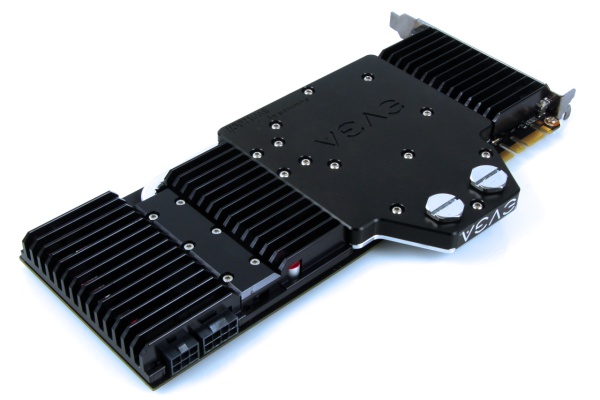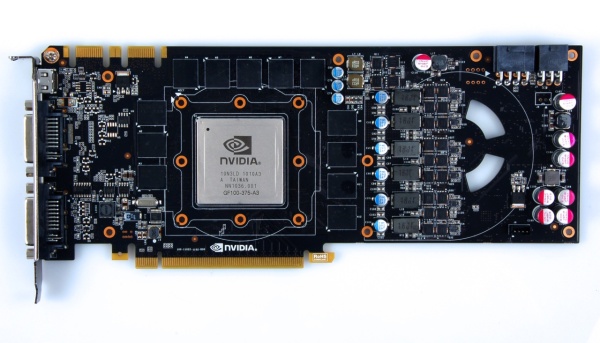EVGA GTX 480 Hydro Copper FTW Review
Closer Look

Watercooling has seen greater mainstream acceptance in recent years. As a result, manufacturers have acknowledged the trend and expanded their product lineups to include these more exotic parts. But what's the big draw for videocards, motherboards, or memory pre-installed with liquid cooling options? Simply put, increased cooling potential nets higher overclocking headroom which translates into higher, stable operating frequencies and ultimately, greater performance. In this particular case, performance is anchored by lower component temperatures and a quieter computing environment as well.
The Hydro Copper GTX 480 measures 10.5" in length, making it one of the longer cards on the market. It is an inch longer than the GTX 470, which measures 9.5", but is much shorter than ATI's HD 5970, which checks in at 12" long.
Along the top edge of the card, we find some important connections. Like the reference design, EVGA's HC FTW GTX 480 requires two power jacks, one 6-pin and one 8-pin PCI Express connectors. Dual SLI connectors enable multi-card gaming, making it possible to link up to four of these monsters on the same motherboard.
EVGA teamed up with Swiftech to produce the waterblock found on this card. Within it, the Hydro Copper uses a 0.6mm thin pin matrix, while the shiny base plate consists of chrome plated C110 copper. The top plate is made of sturdy black derlin, and an integrated heat pipe connects the block to the mosfet heatsink for additional cooling ability.
With the waterblock removed, we can clearly see NVIDIA's reference design GTX 480. The GF100 GPU is a huge chip, and we understand why it requires so much cooling. The black PCB is pretty much standard on all high end graphics cards, with less expensive models sometimes sporting other colors.
There are a couple of things to note on the PCI bracket of this card. First, it has three available connections, just like the standard GTX 480. You get a mini-HDMI port along with two dual-link DVI connectors. Just remember that NVIDIA Surround technology requires two current generation videocards so don't expect multi-monitor gaming capability from a single product. Secondly, EVGA has replaced the reference design dual slot bracket with a single slot option, freeing up adjacent PCI slots on the motherboard for other purposes. Too often, we find watercooled videocards sporting the stock dual slot bracket, negating one of the advantages of using a single slot waterblock.



Included with the GTX 480 HC FTW is an accessory bundle that makes the installation a simple affair. There is a quick start guide, driver disc, DVI-to-VGA adapter, and HDMI-to-mini HDMI cable. EVGA thankfully included a set of 1/2" and 3/8" stubby fittings with corresponding hose clamps. And they didn't let us down on the software front either. The driver disk contains EVGA Precision, OC Scanner, SLI Enhancement, NVIDIA's Supersonic Sled Demo, and the Design Garage Demo.












